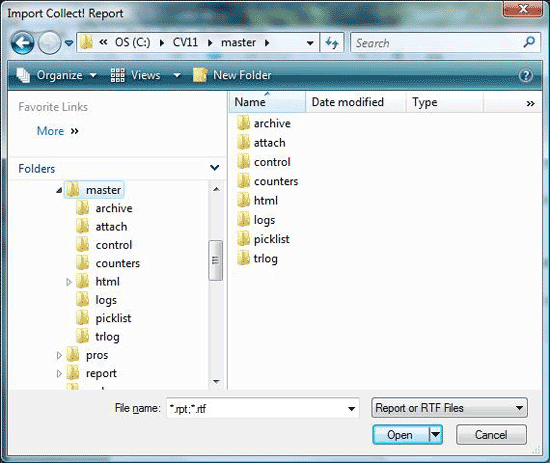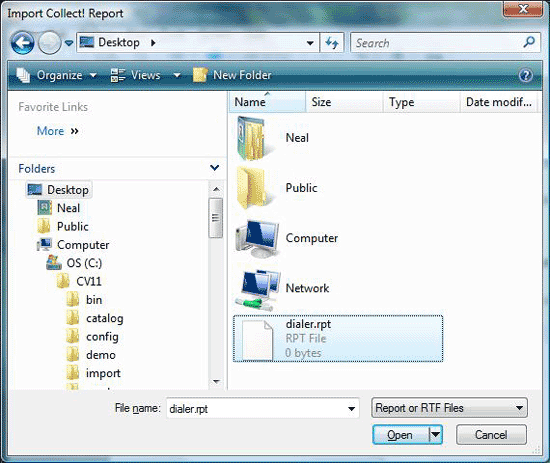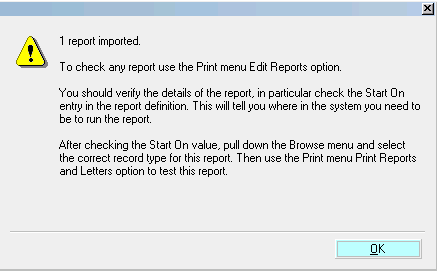How To Import A Report
This topic gives you the steps to import a report into
your database. Importing a report takes only seconds
and saves you from having to enter the code manually.
You can import, test and see results within minutes.
If the report is exactly what you want, great. If not,
delete it and import another very quickly.
You can get report codes from several sources:
* Collect! has many sample reports in the Demodb database.
You can export them and then import them into your
Masterdb database.
* Collect!'s web site has a great many reports that you
can download and import.
* Comtech Systems support team may send you
a custom report or a report that you are having a problem
with.
* You may receive a report from another Collect! user.
To use these reports, you import them into your database.
Is the report attached to an email from Comtech Systems?
Then please save this attachment to a location on
your computer where you know you will be able to
find it. For example, save it to your Desktop.
Are you downloading the report from Collect!'s web site?
Then you will be prompted to save it when you do
this. So please make note of where you save it on
your computer. Also, make note of the name you
save it as. Save it with the *.rpt extension.
 Collect! can only read *.rpt files. If you
save to file as *.txt, please Right click on it, select
rename and either take off the .txt,
or replace it with .rpt.
Collect! can only read *.rpt files. If you
save to file as *.txt, please Right click on it, select
rename and either take off the .txt,
or replace it with .rpt.
When you have the report on your computer and
you know where to find it, proceed with the
steps below to import your report into Collect!
1. Sign into Collect! as you would normally and
select Print from the top menu bar.

Print Menu
2. Then select Customize Printing, Import Report Template.
The Import Collect! Report dialog pops up.

Import Collect! Report Dialog
3. Locate your report file. If you know the location
and name, you can type this into the Filename:
box. Or, you may use the down arrow next to
the Look In: box to navigate to
the Desktop or to the folder where you saved your *.rpt file.
When you see your *.rpt file, click on it and the name
will appear in the Filename: box.

Report File To Import
4. Select Open to import the report.
You may be asked: "Printer codes detected. Do
you want to overwrite your printer control codes?"

Prompt to Import Printer Control Codes
Select NO unless you are sure you want to overwrite
your current printer control codes.
 If you are importing a report that has updated
Printer Control Codes, please select YES here to
overwrite your report codes with the new updated set.
If you are importing a report that has updated
Printer Control Codes, please select YES here to
overwrite your report codes with the new updated set.
5. Your report will be imported immediately and a
message will show the full name of the report you
imported on the very first line.

Imported Report Confirmation Message
Please make note of the full name of the report you just
imported. This is the name that you will use to locate it
in the Report Definition list.
Select OK to close the window.
6. Now check out the report's results! Print a sample
to make sure the output is what you expect. Please
see How To Print A Sample Report Or Letter for more
details.
Tech Notes
Placing report in the report list
To place the imported report in a particular section of your
Report Definition, open the Report Definition list before you
start the import process and select the place in the list
by pressing your space bar.
@include files
If the report you are importing uses an @include file,
make sure that you save the @include file to your
Collect! application's STYLES
folder, (e.g. CV11\styles) so that your
report can load it when you print the report.
Viewing a report outside of Collect!
If you try to open your report, or print it, and you generate
an error message or see gobbledy-gook, it may be that
the report was opened in a word processor and is corrupted.
Collect! imports ASCII text report files. If you need to open
an *.rpt file outside of Collect!, please open with a text editor
that will not change the format. If you open with a word
processor, MAKE SURE you save it as a text file and not
in the word processor's default format as this will make
the file unusable by Collect!.
 Please be aware that imported reports DO retain
any additional settings contained in the report definition's
Report Options.
Please be aware that imported reports DO retain
any additional settings contained in the report definition's
Report Options.

See Also
- Import a Group of Reports
- How To Export A Report
- How To Copy Reports To Master Database
- Report Sample to view sample reports and letters
- Report Topics Index for a list of all report and letter topics

| 
Was this page helpful? Do you have any comments on this document? Can we make it better? If so how may we improve this page.
Please click this link to send us your comments: helpinfo@collect.org